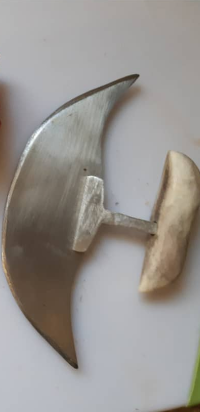'U' is for Ulu
Written by Jenelle Doyle, Archivist, Library and Archives Canada
Many know uluit [plural form of “ulu”] as “Inuit women’s knives”, but they are much more than that and have long remained important symbols throughout Labrador. Ulu patterns are seen in many Labrador crafts, like slippers, etched glassware, embroidery, sealskin crafts, jewelry, carvings, and much more. Uluit can even be seen in some architecture: the school in North West River is shaped like an ulu when viewed from above. It’s hard to go through Labrador without seeing an ulu in one form or another.
Uluit are used for many important tasks, traditionally by women: scraping sealskin, caribou, polar bear, and other pelts; cutting hide and sinew for sewing; cutting and preparing food; eating; scraping the inside of an illuvigak [snow house]; and many more things. Traditionally, each ulu was crafted to fit the hands of the woman who would use it. Though uluit are considered a women’s tool, men are usually the ones who create them. The size of an ulu depends on whom it is made for and what it will be cutting. Uluit used for sewing will have smaller blades, while uluit meant to cut kuak [frozen meat] will have a much larger blade, with the handle being fit to the hands of the owner.
The materials used to craft uluit in Labrador have also changed over the centuries. Slate was used by the Thule Inuit around 1400. Later on, Labradorimiut used the remains of European seasonal settlements along the coast to their advantage, making uluit from scraps of iron and other materials that had been left there. Evidence of just such iron uluit were uncovered in an illusuak [sod house] by the Understanding the Past to Build the Future project in southern Labrador. Today, uluit blades are crafted from a variety of metals, especially steel, while the handles are made from wood, bone or antler. My own personal ulok [the dual form of “ulu”] were made from an old saw blade, for example: one with a driftwood handle and the other with an antler handle.
Uluit go far beyond just being useful tools. For many women, receiving an ulu signifies a coming-of-age. For some women, their uluit become extensions of their hands: that is how skilled one can become over time and how deep the connection between women and uluit can be. Uluit are at the center of knowledge transmission from a woman to her panik [daughter], and they are cherished within families generation after generation. A woman could use one ulu her whole life and then pass it down! Although versions of uluit are available commercially, it is important to support local Inuit artisans who continue to craft uluit so as to support the continued transmission of culture and knowledge.
Jennelle's own personal ulu (photo by Jennelle Doyle):

For more information on uluit:
Check out The Ulu: Chemistry and Inuit women’s culture by Chaim Andersen.
For more photos:
Check out the Eva Luther Family Heirlooms from the Eva Luther Collection (used with permission).
Back to all Encyclopedia entries